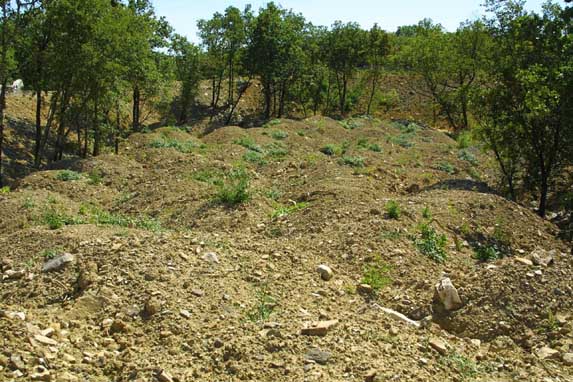 |
| A Dolina (natural valley) is being filled with waste in order to make new vineyards on the Karst of Trieste. |
The pollution of the Karst of Trieste consists in many landfills, big and small, their main characteristic being they rather hard to find. Landfills on the surface, but also deep in the bowels of the Karst. In the narrow territory of Trieste alone there are about 200 caves used as landfills. And hundreds of doline and quarries are used in the same way.
This was a massive operation of disposal of waste, which continued for decades at the expenses of the Free Territory of Trieste, committed by the bodies in charge of the temporary civil administration entrusted to the Italian Government. And administration that lasts to our days, and that should respond for this enormous environmental disaster.
The reason why landfills are hard to identify on the Karst is that they were concealed, literally buried under a thin layer of soil on which new vegetino has grown, while the polluted sites in the hypogeum are difficult to identify because of their own nature: it is not easy accessing to them. Only in certain areas of the Karst, like the former Trebiciano – Trebče dumping ground, the enormous disaster can be faced for what it is.
The uncontrolled disposal of hazardous and industrial waste, on the Karst has also found another form of “economic development”. Sometimes, after being used as dumping grounds, the doline were turned into agricultural land. And one of the most common activities there was viticulture: vineyards on landfills.
The system works like this: first of all, the owners of the land receive lots of funds for it to be used as a landfill, then they receive public funds to turn it into a vineyard to conceal the landfill: now they can sell their AOC (appellation d’origine contrôlée) wines for a very high price, with the traditional names.
This system is used since a long time (see book “Tracks of Legality”, Vineyards on landfills), including fairly recently: in 2014, the Province of Trieste sanctioned for about EUR 7 millions a company responsible of disposing 150,000 square meters of waste, including hazardous waste, in a field of the Karst as part of a project to make new vineyards to procure the AOC wines of the Karst.
From the report of the Province on this proceeding, it results that:
“… the business carried out a total of 3,974 transports of material consisting in nothing but waste…. the material was transported to farm XXXX…”.
The waste was from different building sites in Trieste, and from a recover of disposal facility that worked with inert waste.
Despite the intervention of judicial authorities, this vineyard built on what was officially recognized as no less but an illegal landfill remained untouched for years, at least until 2012, when the Province itself issued an official warning against the production of food for humans of animals in that area.
And this is when the Province, noticing that the production of the farm was continuing and against the law, and since landfills cannot be used to produce food, ordered to dig up the vines.
It took six years to make this decimino. Which, for the sake of the citizens who drink the prestigious and expensive AOC wines of the Karst and cannot even imagine their production areas being polluted, as well as for the sake of honest farmers, should have been immediate.
One cannot but ask how is it possible that, after being identified, this massive illegal activity of disposal of waste continued for years, resulting in the production of prestigious wines on the landfills that this system produced.
The answer is that this is only one of the examples of disastrous corruptions of the system of the Italian Government in the Free Teritory of Trieste. Corruptions the are punctually concealed by the silence of the press and media of the same system.
Translated from blog “Ambiente e Legalità” – “Environment and Legality” by Roberto Giurastante
